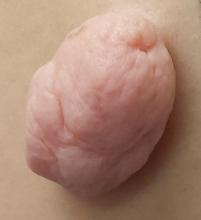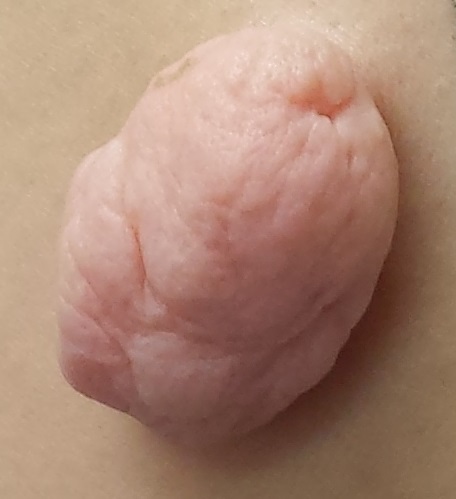User login
A 49-year-old woman presents to dermatology with a lesion on her back. It’s been there for at least 20 years, slowly growing to its present size; it is now so prominent that it shows through her clothes and is subject to traumatization. The visibility of the lesion, particularly when the patient wears a swimsuit, is a source of considerable embarrassment.
Notable medical history includes polycystic ovarian syndrome and related diabetes and dyslipidemia. Family history reveals that the patient’s mother died of heart disease in her 40s.
EXAMINATION
The lesion, which measures 3 cm x 3 cm, is an impressive, pedunculated, doughy, rubbery, skin-colored mass protruding from her left mid back. No redness or edema is seen on or around the lesion. On palpation, the lesion is found to be uniformly soft and rubbery.
The patient is quite obese and has numerous skin tags in skin folds, under the arms, and around the neck.
What is the diagnosis?
DISCUSSION
The lesion was excised with deep margins and submitted to pathology. The report showed benign histology, consistent with a fibroepitheliomatous polyp.
In one sense, it’s hard to believe this huge lesion was a “skin tag,” and there are other things it might have been. But the microscopic examination of the tissue proved it was simply a large version of the same skin tags we see around necks and in axillae. These lesions are known by various names, including fibroepitheliomatous polyps (FEP) and acrochordons. A more typical FEP would be the size of a grain of rice, but they can take on various forms and sizes.
There is a differential for lesions that look like FEPs; it includes seborrheic keratoses, warts, molluscum contagiosum, neurofibromas, and fibrolipomas. Even melanoma and squamous cell carcinoma can assume a tag-like morphology. So it pays to take a close look at these lesions, checking to see if they’re soft and pliable, as well as skin colored. With any odd feature, including increased size, they need to be removed and sent for pathologic examination.
Heredity appears to play a role in the development of FEPs, as do age and obesity. There are studies showing an association between FEPs and insulin resistance and others identifying FEPs as a marker for increased risk for atherosclerotic vessel disease. In any case, 59% of the population has them by age 70, with men and women affected equally. Of the general population, 46% has some sort of skin tag somewhere.
Treatment may entail cryotherapy, excision, or electrodessication. With lesions as large as the case patient’s, excision is the only reasonable option. Deep margins are required, since a “shave” would leave a gaping, open wound. For the case patient, there was no postoperative sequelae aside from some scarring.
TAKE-HOME LEARNING POINTS
• Skin tags, also known as fibroepitheliomas, fibroepitheliomatous polyps, or acrochordons, are typically the size of a grain of rice, and tend to appear in skin folds (eg, axillae, neck, groin).
• Studies have shown that there may be an association between having skin tags and developing CAD or insulin resistance.
• Obesity, age, and heredity also appear to be factors in developing skin tags.
• Large or odd tags need to be captured and sent for pathologic examination.
• Skin tags are extremely common, affecting 59% of the population older than 70.
A 49-year-old woman presents to dermatology with a lesion on her back. It’s been there for at least 20 years, slowly growing to its present size; it is now so prominent that it shows through her clothes and is subject to traumatization. The visibility of the lesion, particularly when the patient wears a swimsuit, is a source of considerable embarrassment.
Notable medical history includes polycystic ovarian syndrome and related diabetes and dyslipidemia. Family history reveals that the patient’s mother died of heart disease in her 40s.
EXAMINATION
The lesion, which measures 3 cm x 3 cm, is an impressive, pedunculated, doughy, rubbery, skin-colored mass protruding from her left mid back. No redness or edema is seen on or around the lesion. On palpation, the lesion is found to be uniformly soft and rubbery.
The patient is quite obese and has numerous skin tags in skin folds, under the arms, and around the neck.
What is the diagnosis?
DISCUSSION
The lesion was excised with deep margins and submitted to pathology. The report showed benign histology, consistent with a fibroepitheliomatous polyp.
In one sense, it’s hard to believe this huge lesion was a “skin tag,” and there are other things it might have been. But the microscopic examination of the tissue proved it was simply a large version of the same skin tags we see around necks and in axillae. These lesions are known by various names, including fibroepitheliomatous polyps (FEP) and acrochordons. A more typical FEP would be the size of a grain of rice, but they can take on various forms and sizes.
There is a differential for lesions that look like FEPs; it includes seborrheic keratoses, warts, molluscum contagiosum, neurofibromas, and fibrolipomas. Even melanoma and squamous cell carcinoma can assume a tag-like morphology. So it pays to take a close look at these lesions, checking to see if they’re soft and pliable, as well as skin colored. With any odd feature, including increased size, they need to be removed and sent for pathologic examination.
Heredity appears to play a role in the development of FEPs, as do age and obesity. There are studies showing an association between FEPs and insulin resistance and others identifying FEPs as a marker for increased risk for atherosclerotic vessel disease. In any case, 59% of the population has them by age 70, with men and women affected equally. Of the general population, 46% has some sort of skin tag somewhere.
Treatment may entail cryotherapy, excision, or electrodessication. With lesions as large as the case patient’s, excision is the only reasonable option. Deep margins are required, since a “shave” would leave a gaping, open wound. For the case patient, there was no postoperative sequelae aside from some scarring.
TAKE-HOME LEARNING POINTS
• Skin tags, also known as fibroepitheliomas, fibroepitheliomatous polyps, or acrochordons, are typically the size of a grain of rice, and tend to appear in skin folds (eg, axillae, neck, groin).
• Studies have shown that there may be an association between having skin tags and developing CAD or insulin resistance.
• Obesity, age, and heredity also appear to be factors in developing skin tags.
• Large or odd tags need to be captured and sent for pathologic examination.
• Skin tags are extremely common, affecting 59% of the population older than 70.
A 49-year-old woman presents to dermatology with a lesion on her back. It’s been there for at least 20 years, slowly growing to its present size; it is now so prominent that it shows through her clothes and is subject to traumatization. The visibility of the lesion, particularly when the patient wears a swimsuit, is a source of considerable embarrassment.
Notable medical history includes polycystic ovarian syndrome and related diabetes and dyslipidemia. Family history reveals that the patient’s mother died of heart disease in her 40s.
EXAMINATION
The lesion, which measures 3 cm x 3 cm, is an impressive, pedunculated, doughy, rubbery, skin-colored mass protruding from her left mid back. No redness or edema is seen on or around the lesion. On palpation, the lesion is found to be uniformly soft and rubbery.
The patient is quite obese and has numerous skin tags in skin folds, under the arms, and around the neck.
What is the diagnosis?
DISCUSSION
The lesion was excised with deep margins and submitted to pathology. The report showed benign histology, consistent with a fibroepitheliomatous polyp.
In one sense, it’s hard to believe this huge lesion was a “skin tag,” and there are other things it might have been. But the microscopic examination of the tissue proved it was simply a large version of the same skin tags we see around necks and in axillae. These lesions are known by various names, including fibroepitheliomatous polyps (FEP) and acrochordons. A more typical FEP would be the size of a grain of rice, but they can take on various forms and sizes.
There is a differential for lesions that look like FEPs; it includes seborrheic keratoses, warts, molluscum contagiosum, neurofibromas, and fibrolipomas. Even melanoma and squamous cell carcinoma can assume a tag-like morphology. So it pays to take a close look at these lesions, checking to see if they’re soft and pliable, as well as skin colored. With any odd feature, including increased size, they need to be removed and sent for pathologic examination.
Heredity appears to play a role in the development of FEPs, as do age and obesity. There are studies showing an association between FEPs and insulin resistance and others identifying FEPs as a marker for increased risk for atherosclerotic vessel disease. In any case, 59% of the population has them by age 70, with men and women affected equally. Of the general population, 46% has some sort of skin tag somewhere.
Treatment may entail cryotherapy, excision, or electrodessication. With lesions as large as the case patient’s, excision is the only reasonable option. Deep margins are required, since a “shave” would leave a gaping, open wound. For the case patient, there was no postoperative sequelae aside from some scarring.
TAKE-HOME LEARNING POINTS
• Skin tags, also known as fibroepitheliomas, fibroepitheliomatous polyps, or acrochordons, are typically the size of a grain of rice, and tend to appear in skin folds (eg, axillae, neck, groin).
• Studies have shown that there may be an association between having skin tags and developing CAD or insulin resistance.
• Obesity, age, and heredity also appear to be factors in developing skin tags.
• Large or odd tags need to be captured and sent for pathologic examination.
• Skin tags are extremely common, affecting 59% of the population older than 70.

